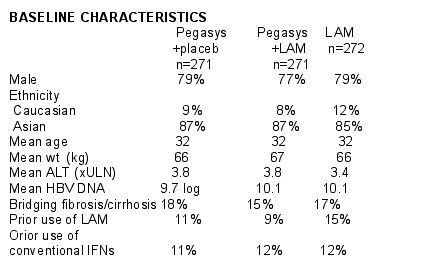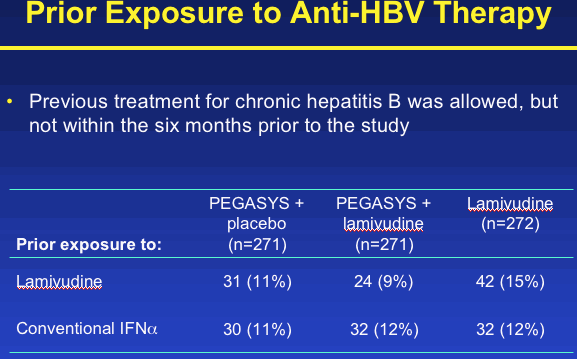 |
 |
 |
| |
Effect of Previous HBV Therapy on Pegasys+Lamivudine for HBV
|
| |
| |
"Peginterferon Alfa-2a (40KD) (PEGASYS) vs. Peginterferon alfa-2a Plus Lamivudine vs. Lamivudine in HBeAg-positive Chronic HBV: Effect of Previous Treatment and Drug Exposure on Sustained Response"
These study results were reported at the 40th annual meeting of EASL in Paris April 2005 by George KK Lau, Department of Medicine, Queen Mary Hospital, University of Hong Kong, Hong Kong, China
Reported by Jules Levin
In chronic hepatitis C, previous treatment and extent of drug exposure seem to have an impact on response rates. In patients with chronic hepatitis B (CHB) the effects of previous anti-HBV treatment and exposure to study drug on responses to pegylated interferon are less well investigated.
The objective of this analysis was to investigate the effect of previous treatment and drug exposure on efficacy and safety in a randomised, partially double-blind, multinational study.
SUMMARY:
The study authors reported that prior treatment with lamivudine or interferon did not substantially affect HBeAg seroconversion rates in this study:
--HBeAg seroconversion rates in patients without prior anti-HBV therapy were almost identical to those seen in the overall population. Patients with prior HBV therapy experience had similar HBeAg seroconversion rates as the overall population & as those without prior HBV therapy experience (see actual data below)
--HBeAg seroconversion rates were still significantly higher with Pegasys alone than with lamivudine monotherapy, irrespective of previous anti-HBV therapy.
EFFECT of Pegasys Drug Exposure on Sustained Response
Drug exposure in the study was very high:
--78% of patients received >=90% of the total pegasys dose.
Due to the relatively small number of patients receiving <90% of the pegasys dose it is difficult to determine an exposure/efficacy relationship. Nevertheless, a high rate (28%) of HBeAg seroconversion was achieved with Pegasys even in patients who received <90% of the study dose.
HBeAg-positive patients (ITT population: n = 814) received (1:1:1) either peginterferon a-2a (180 µg once-weekly) + placebo, or peginterferon a-2a + lamivudine (100 mg once-daily) or lamivudine. Patients were treated for 48 weeks and assessed 24 weeks after the end of treatment (week 72). Treatment with any anti-HBV drug 6 months before study entry was not permitted. Analysis of drug exposure was performed only in the peginterferon a-2a monotherapy arm.


FACTORS PREDICTIVE OF RESPONSE IN HBeAg-POSITIVE CHRONIC HEPATITIS B
Common across conventional IFNs & Lamivudine
--high pretreatment ALT
For response to conventional IFNs & Lam
--low pretreatment HBV DNA
--high degree of necroinflammatory activity
--infection as an adult
For response to conventional IFNs only
--genotype B (vs C)
--genotype A (vs D)
PARAMETERS SIGNIFICANTLY ASSOCIATED WITH HBeAg-SEROCONVERSION IN THE MULTIVARIATE ANALYSIS
Treatment with Pegasys
--2x higher chance of response vs LAM treatment
ALT at baseline
--2.7x higher chance of response for each 10-fold higher ALT (eg 320 IU/L vs 32 IU/L)
HBV DNA at baseline
--2-% higher chance of response for each log lower (eg 8.5 log vs 9.5 log)
HBeAg levels at baseline
--50% higher response for each log lower
EFFECT OF PREVIOUS TREATMENT on SUSTAINED RESPONSE
In this study, patients who had received prior anti-HBV therapy were enrolled, but on the condition that no ant-HBV therapy had been used in the 6 months before the start of the study. Overall, between 9-15% of patients had previously been treated with lamivudine. And between 11-12% had previously received conventional IFN therapy.

How does the inclusion of these patients with previous anti-HBV therapy impact on the results of the study?
As this slide below shows, previous treatment with lamivudine or interferon did not substantially affect HBeAg seroconversion rates in the study. The important point here is that HBeAg seroconversion rates at week 72 were still higher with Pegasys monotherapy than with lamivudine monotherapy irrespective of previous anti-HBV therapy. In one subgroup (prior exposure to lamivudine), the P-value just missed significance due to the small number of patients in this subgroup.


As prior exposure to lamivudine or interferon had no effect on HBeAg seroconversion rates, it follows logically that when we look at patients without prior ant-HBV therapy, the HBeAg seroconversion rates are almost identical to those seen in the overall population. Again, the important point here is that HBeAg seroconversion rates at week 72 were consistently and significantly higher with PEGASYS monotherapy than with lamivudine monotherapy.
EFFECT of PEGASYS DRUG EXPOSURE on SUSTAINED RESPONSE
All patients randomized to Pegasys (n=271) started treatment with 180 ug once weekly. In total, 109 (40%) of patients required a Pegasys dose modification for adverse events and/or lan abnormalities. Lab abnormalities were main reasons for dose modification: neutropenia (22%) >ALT elevations (12%) >thrombocytopenia (9%) (platelets).
Overall, exposure to Pegasys was high:
--total study dose=8640 ug Pegasys (ie, 48 weeks of pegasys at 180 ug/week)
--211 (78%) patients received >=90% of the total Pegasys dose (ie, >+7776 ug Pegasys)
If we look at the rate of HBeAg seroconversion in patients who received less than 90% of the total dose, they responded almost as well as those who received >=90% of the total study dose. The rate of response was slightly lower in patients who had received <90% of the total dose. However, the difference was not significant . Pegasys was effective in achieving HBeAg response in patients who received <90% of the dose.

The mean PEGASYS dose for the non-responders was very similar to that for the non-responders:
--Responders mean dose was 5303 (range 540 7560)
--Non-responders mean dose 5542 (range 360 7695)
Based on these data it would seem that among patients receiving less than 90% of the PEGASYS dose there was no difference in exposure between responders and non-responders. However, this observation is based only on relatively few patients and needs to be interpreted with caution.

|
|
| |
| |
| |
|
 |
 |
|
|